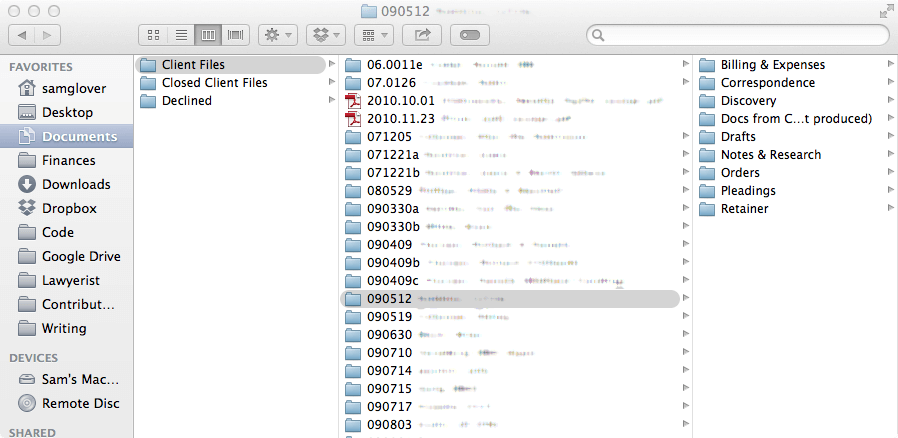How Best to Organize a Family Law Office
Organizing paperless client files is simple: organize digital client files exactly how you organized your files before you went paperless. Go with the "folder" analogy that your computer uses for organizing files, and use them just as you use your red ropes and manila folders.
Consider your "paper-full" workflow. You lot probably get a document in the mail, review information technology, so two-pigsty-punch it and add together it to a manila folder, which is put in a red rope "saucepan file" and stored in your filing cabinet (or in a stack next to your desk-bound). A paperless workflow is like, only most of information technology happens on your estimator. Later on you become a document in the post, scan it and file information technology in a folder on your computer. That binder is similar to the manila folder, and it should be located within a folder for the client (the red rope) that is, in plough, stored in aClient Files binder (your filing chiffonier).
Customer files folder structure
Here is an overview of how I organize my client files:

This is a screen capture from my bodily customer files annal, so I've blurred out the names of my clients, just you go the idea.
Instead of a filing chiffonier, I have a folder called Client Files. Inside that folder are sub-folders (ruby ropes) for all of my client files. Each affair has the file number and customer's final name. You can employ your /Client Files folder equally a "tickler" for work planning meetings if you are reasonably diligent about closing files.
Within my /Documents folder, I also take folders labeled Billing,Temporary, Closed Client Files, andDeclined. (The Billing andTemporary folders are not shown in the image in a higher place, because it comes from my annal.) Here's how I apply each folder.
- Customer Files. These are open files. I utilize a file closing checklist to close files promptly when they are finished.
- Billing. Files that have been closed, just for which the customer nevertheless owes me coin.
- Temporary. Whatever notes, intake forms, or other documents related to clients who take non even so signed a servant.
- Closed Client Files. Self-explanatory, except for one important point. I return all paper to the client, together with a CD containing a complete re-create of their digital file. I go along my digital re-create for x years, then delete it (the client receives discover that this volition happen in the closing letter of the alphabet).
- Declined. Files get moved here from theTemporary folder when the customer decides not to sign a retainer, or when I decide non to stand for the client.
I also have a Customer Files Archive folder in my Documents folder with a binder for each year. At the stop of each yr, I move all the inactive (closed and declined) files into an archive folder for that year. It helps keep my Client Files binder uncluttered and makes it easy to delete archived client files on a ten-year schedule.
Bare new binder template
I keep a bare new folder template handy for new files. Here is what it looks like:

It makes sense to stick your templates in your blank folder, as well. Put your letterhead and envelope templates in your Drafts folder, and a settlement negotiations spreadsheet in your Notes folder.
File numbers
If you do not already have a file numbering scheme, try mine. I decided it was worthless to assign capricious numbers, and started using numbers that reflected the engagement the client signed a retainer. So if the customer signed a retainer on August three, 2016, the file number would be 160803. If multiple clients sign a retainer on the same day, just add a letter, like so: 160803a for the get-go, 160803b for the second, and then on. This makes information technology easy to tell, at a glance, how long a file has been open up. That'due south not data I need all the time, but information technology is more useful than consecutive numbering that says null at all well-nigh the file.
File naming
File naming is also of import. By and large, you would sort documents by the date of the certificate (non the engagement you scanned the document, which may be days—or years—later). To exercise this, outset filenames with the date, year offset: yyyy-mm-dd Filename.pdf. (Yous have to start with the year, or all your Januarys volition terminate upwardly next to one another. I prefer to dissever the elements of the date with hyphens to make information technology easier to read the date when looking at a list of files.
One terminal affair. Do not shop Discussion, WordPerfect, Pages, OpenOffice.org, etc., files in whatever folders other than Drafts or Notes. Those files are not copies of documents. They are malleable drafts that probably look slightly different on dissimilar computers, and can be easily edited. PDFs are documents (and PDF is the file format you should use).
The exception is when a client provides you with a digital certificate. In that case, store it in the format in which you received it in theDocs from Customer folder, since that digital file is the actual document yous were given.
Originally published 2010. Updated 2017. Republished 2019-10-16.
Source: https://lawyerist.com/news/organize-paperless-client-files
0 Response to "How Best to Organize a Family Law Office"
Post a Comment